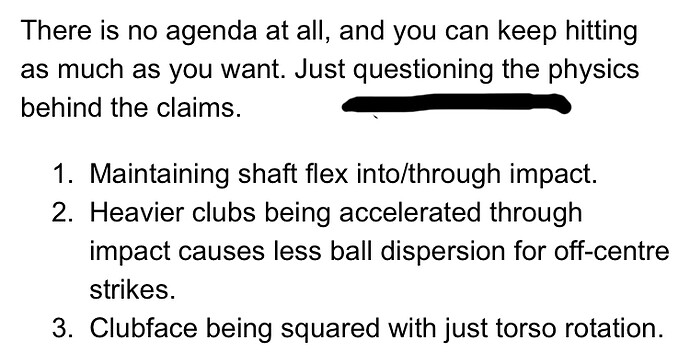I suspect you didn’t read the article whose link I previously posted. The new research was done by other scientists with high tech equipment and Dave Tutelman was doing his best to make it as understandable as possible for non-scientist readers.
“His study of the golf swing and equipment is a hobby. His papers are not academic, they’re not peer-reviewed, and they reek of biased assumptions, unsupported claims, and back-of-the-envelop calculations with numbers we’re just supposed to trust are valid.”
Here is his ‘Golf Technology Biography’
Sports Technology Bio (tutelman.com)
I can say the same for ABS and the very vague claims made about accelerating the club through impact while retaining shaft flex. Further, the claims that there is less dispersion of the golf ball for off-centre strikes for ABS Hitting vs Swinging. There has been no scientific proof to support these claims and I’ve yet to see some hard evidence apart from opinions and old 2D pictures of golfers who are assumed to be ‘Hitters’.
You haven’t read Dave Tutelman’s article ‘Accelerating Through Impact’ (link below) and it might surprise you as he actually wants the golfer to body pivot through impact.
Accelerating Through Impact: Mandate or Myth (tutelman.com)
Not because accelerating the clubhead though impact will have any significant effect on driving distance or decrease dispersion for off-centre strikes but because it puts the golfer’s arms and hands in the correct position to allow the club to release fully just post impact where clubhead speed would peak ideally just after impact (if there wasn’t a ball in the way). For irons especially, this means trying to time the peaking of clubhead speed ideally post impact for a descending blow. For a driver swing, the golfer would have to time the body pivot and club release so that the arms/hands were positioned to meet the intended angle of attack for a more sweeping strike.
DT says
"So there are good things that happen if you retain a bit of wrist cock at impact, especially with irons. One of the things that happens is that the clubhead is accelerating at impact – but that is just a side effect and doesn’t really help you.
A real live human being cannot accelerate the body to impact and not still be accelerating through impact. A golfer thinking only of accelerating to impact is going to quit accelerating before getting near impact. You can’t turn off full-body acceleration in .4 milliseconds, probably not even in 100 milliseconds.
Here, then, is the situation. If you want to maintain the body’s angular acceleration up to impact, you must intend to accelerate through impact. If there is any reason to want angular acceleration to continue fully to impact (and we will see below that there are good reasons), then a good instructor will teach the golfer the intent of accelerating through impact.
In fact, a good instructor will have the golfer exaggerate… Accelerate well beyond impact. If you have taken a lesson where your swing was video’d, and watched the video afterwards, you know this is true. You may intend to make a particular exaggerated move, you may have felt that you made the move successfully, but it is barely there (if at all) on the video. Much of good golf instruction is getting people to greatly exaggerate a correct move, because it is the only way to get the motion to happen at all. So, assuming we want angular body acceleration to continue up to impact, the swing key to be taught is to accelerate well beyond impact."
Another reason for accelerating the torso through impact is that is prevents the golfer hitting ‘at’ the ball and quitting on the strike (see the 2 images below). As you can see, peaking clubhead speed before impact will cause a flipping action with probably a bent lead wrist.

BOTTOM LINE
“Accelerate though the ball” is an excellent swing key, for every shot from a drive to a putt.
But it is better expressed as “rotate your body through the ball” (or perhaps “accelerate moving your hands beyond the ball”), because it is body rotation or “turning the triangle” where acceleration through the ball is beneficial. Consciously accelerating the clubhead through the ball (especially if you do it with the hands, wrists, or forearms) will probably do more harm than good.
Dave Tutelmans old swing is on you-tube (where he was an obvious flipper). Not sure what it looks like today but he can still shoot below his age 81.
![]()

